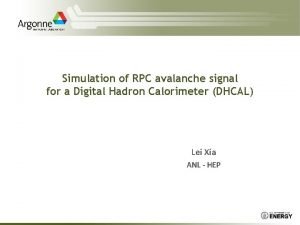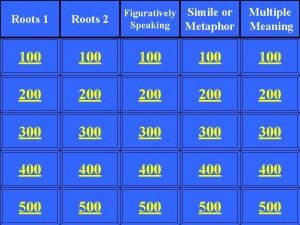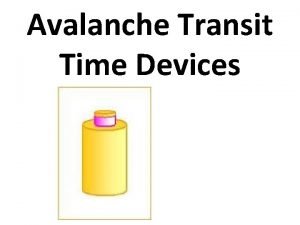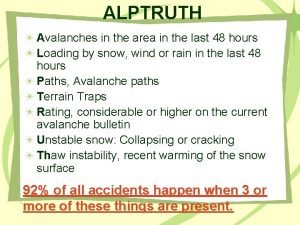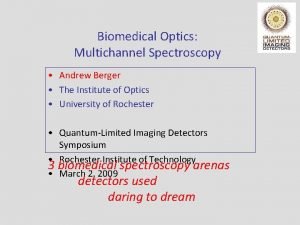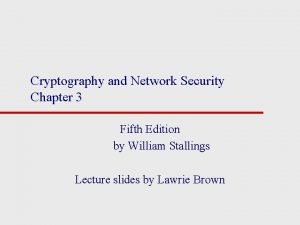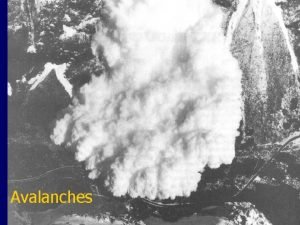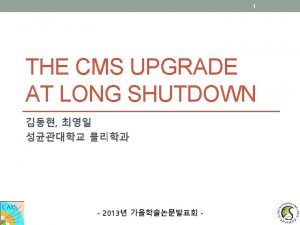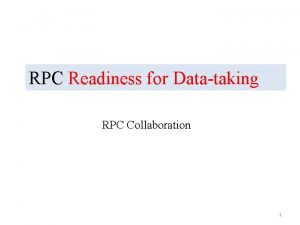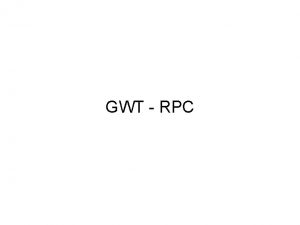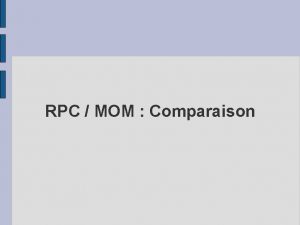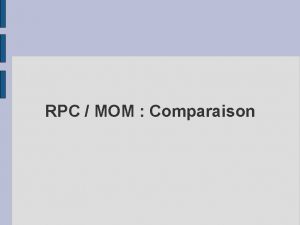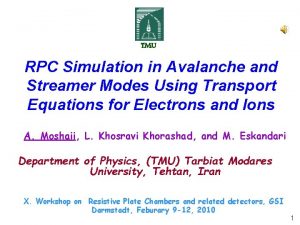Simulation of RPC avalanche signal for a Digital












- Slides: 12

Simulation of RPC avalanche signal for a Digital Hadron Calorimeter (DHCAL) Lei Xia ANL - HEP

Outline § § Why do we need an RPC response simulation Implementation details Recent development Si. D/lcsim implementation

Purpose of RPCsim § § DHCAL: energy is measured with number of hits (to first order), no energy deposition information within each cell Digitization: RPC response simulation that convert energy deposition points into detector hits GEANT 4 simulation Energy deposition/energy/time Hits Geometry RPCsim

Detailed implementation Experimental set-up Beam (E, particle, x, y, x’, y’) GEANT 4 Measured signal Q distribution Points (E depositions in gas gap: x, y, z) RPC response simulation Hits DATA Hits Comparison With muons – tune a, T, (dcut), and Q 0 With positrons – tune dcut Pions – no additional tuning Parameters Exponential slope a Threshold T Distance cut dcut Charge adjustment Q 0

Detailed implementation: avalanche charge Measured charge distribution for HV = 6. 2 k. V Generated charge distributions for different HV settings Randomly sampling the charge distribution Total charge

Detailed implementation: charge distribution Measured charge distribution as function of y in the pick-up plane Energy deposition point (x, y, z) [from Geant 4] Throw 10, 000 points in x, y plane, calculate charge Q(r), sum up charge on 1 x 1 cm 2 pads Assume exponential drop in R (even though the measurement was in Y) Charge on each readout pad

Detailed implementation: parameters and tuning § There are 4 tunable parameters in the simulation – – § Overall charge offset: Q 0 Charge threshold for each readout pad: T Charge spread parameter (slope of the exponential): a Distance cut (within which, only one avalanche is generated): D Parameter tuning – Muon data: Q 0 , T , a – Positron data: D – Pion data: absolute prediction Scan across pad x scan: y constrained to (0. 25, 0. 75) y scan: x constrained to (0. 25, 0. 75)

Recent development: 2 nd exponential § § For muon data taken at Fermilab test beam, we saw an larger than expected tail on the high end of the number of hits distribution Adding a 2 nd exponential with wider charge distribution can match the simulation to data – Two more tunable parameters: a’ (slope of 2 nd exp), R (ratio of the two exp’s) § Systematic comparison using electrons/pions ongoing Simulation with 1 exp Simulation with 2 exp’s

Recent development: look-up table § Original RPCsim is relatively slow – Throw 10 k points for each avalanche, in order to estimate charge on each pad – Randomly sample total charge distribution, to get charge for each avalanche – Both are essentially doing numerical integration potential to save run time § Implementation of pre-calculated look-up tables – Avalanche charge generation is straight-forward: • Numerically integrate the charge distribution to high precision • Map the integration to [0, 1] and generate look-up table • Generate single random number in [0, 1], and lookup/interpolate to get charge – Charge distribution is more complicated, need 2 -D lookup table • Calculate in a single pad (only 1/8 are needed due to symmetry) with very fine grid (200 x 200 points on 1 cm x 1 cm pad, which is also the look up coordinates) • For each grid point, perform precision numerical integrate to calculate fraction of charges in nearby 3 x 3 or 5 x 5 pads (table entries) • Lookup/interpolate to get fraction of charge on each pad, according to in-pad position § Using the look-up tables is much faster, but generating the distribution table is not – Original RPCsim is used in the parameter tuning – Look-up table will be used in production, once the parameters are fixed

Si. D/lcsim implementation § § So far the RPCsim has been used as a stand alone step in test beam simulation Recently made an effort to make it available for detector/physics studies – People would like to (at least) see if there’s a significant difference between RPCsim and a much more simplified version used in the physics studies – RPCsim parameters still need some fine tuning, but are already good enough for detector/physics studies – Would require additional simulation information that was not in the standard Si. D simulation output: position of all energy deposition points in RPC gas § § Norman Graf / Jeremy Mc. Cormick kindly provided new data samples that has the required information Jan Strube helped with setting up latest lcsim

Si. D/lcsim implementation § Si. D/lcsim implementation is basically a rewrite of the look-up table version – Most part is relatively straight forward – Some complication with the geometry, finding neighboring cells and local coordinate – Generated hits are currently stored in a self-defined simple hit class § My part of job is considered done – Output hits need to be stored into more appropriate data structure: expect experts (Norman/Jeremy) to take over and finish it § Did very limited/simple check: looks OK Before RPC simulation: only energy deposition points After RPC simulation: digital hits

Summary § § RPC response simulation has been developed based on total charge and charge distribution measurements, with a few tuning parameters Parameters are being tuned according to test beam data Several improvement of the simulation implemented to improve data/simulation agreement and running speed Implementation in Si. D/lcsim is (almost) done
 Avalanche rpc
Avalanche rpc Digital signal as a composite analog signal
Digital signal as a composite analog signal Digital encoding schemes
Digital encoding schemes Publik sektor
Publik sektor The avalanche devoured everything in its path
The avalanche devoured everything in its path معنیroots
معنیroots What are avalanche transit time devices
What are avalanche transit time devices Alptruth avalanche
Alptruth avalanche Andrew berger rochester
Andrew berger rochester Avalanche effect in des with example
Avalanche effect in des with example Avalanche
Avalanche Avalanche terminology
Avalanche terminology Class 5 avalanche
Class 5 avalanche
